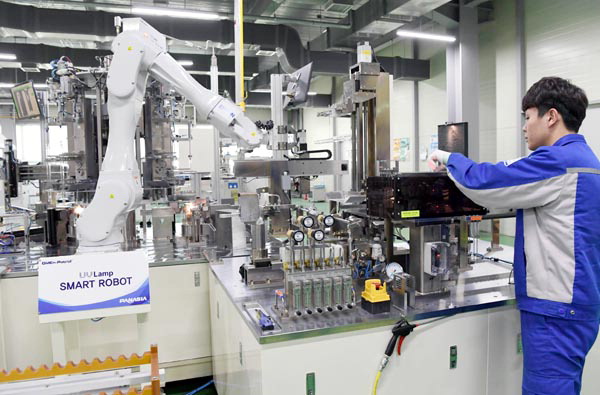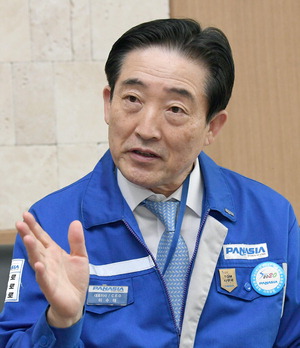
- This is PANASIA
- ESG Management
- History
- Smart PANASIA
- Contact information
 About
About
Check PANASIA introduction,
ESG management, and History
information
- Energy Solutions
- Air Solutions
- Water Solutions
 Eco-friendly Solution
Eco-friendly Solution
About Global environmental
regulation, Hydrogen business,
Air quality, and Water quality
environment solutions
- Product Service
- Service Network
- Customer Service
 Customer Support
Customer Support
Check the Panasia’s
after service
- About
- Eco-friendly Solution
- Customer Support
- Media
NEWS
In Search of Smart Factory <4> PANASIA
Shipowners place orders without hesitation following a visit to our automation process … “Best marketer at our plant”
- Ballast water treatment system manufacturer
- Adopted robots for glass forming and bonding
- Saved entire manufacturing process as data
- Reduced defect rates for key components by 85%
- Gained cost competitiveness in addition to quality improvement
- Planning to create ICT control system
Soo-tae Lee (63), CEO of PANASIA, experienced an epiphany during his 2015 visit to a Rolls-Royce plant in the UK. He saw an operator handling three machines as big as houses. The operator was manning the machines alone, leaving the rest of the work to the machines. Each machine was operating on its own, connected to an Internet of Things (IoT) network. When the indoor temperature rose, the air conditioner would start running, lowering the temperature. The entire process was automated. After seeing a smart factory in person for the first time, Lee immediately started working to implement a smart factory at PANASIA, a marine equipment supplier he founded.
 |
This is a PANASIA employee working on a UV lamp on the 11th at the headquarters in Gangseo-gu, Busan. In 2015, marine equipment supplier PANASIA began adopting data and internet of things to implement a smart factory.
Lee recalled, “I was shocked when I saw a smart factory for the first time. I saw something similar at a beer brewery in Japan. There was not a single manual worker throughout the whole process, from processing raw materials to making beer, and to packaging and loading trucks. In October 1989, Lee founded PANASIA, a marine equipment supplier that manufacturers ballast water treatment systems. PANASIA, which is celebrating its 29th anniversary this year, has developed marine de-SOx scrubbers using its own technology and started shipping them. Scrubbers useseawater to clean and remove sulfur in ship exhaust gas emissions.
■ Output increases from 80 to 300
 |
PANASIA’s headquarters in Gangseo-gu, Busan, on the 11th. A robot grabs and transfers thin, clear glass tubes. The tubes contain bits of the filament transferred by another robot. Before the smart process was adopted, people did all the work manually, from glass forming to bonding, and to heat treatment. Now, the whole process has become smart. With support from Busan Techno Park and the Busan headquarters of Korea Industrial Complex Corporation, PANASIA has adopted the smart process.
PANASIA utilizes smart manufacturing to make UV lamps, which disinfect the water in ballast water treatment systems. UV light is a key part of a ballast water treatment system. Through a two-stage process, PANASIA’s ballast water management system kills organisms present in ballast water. First, it filters the water to separate organisms larger than 50㎛. Second, it uses UV light to disinfect the ballast water and remove all organisms before discharging the water into the sea.
Smart manufacturing helped increase daily UV lamp output to 300 from 80 units, the previous output of seven experienced operators. Since every part of the lamp production process is saved as data, defect rates are reduced by 85%. By adopting the smart factory, PANASIA has improved both productivity and quality, gaining a competitive edge in manufacturing costs. Lee stressed, “Adopting a smart factory doesn’t necessarily mean fewer employees. We had seven employees working in the UV lamp process, and we still have seven employees in the same process. We did have automated equipment in the past, too, but automation takes on a whole new meaning with the smart factory. With the smart factory, machines move, accumulate data, perform deep learning, and increase productivity.”
Smart Factory is the Answer
This year, PANASIA began a two-year joint research project with professor Yoo Myeong-hwan’s team at the Pusan National University School of Electrical and Computer Engineering, under the title “On-site Environmental Data Acquisition and Lamp Life Expectancy Forecast using Information and Communications Technology (ICT).” First, the team gathers data using sensors installed in UV lamp manufacturing processes as well as sensors that use UV lights. The data help determine a product’s expected service life based on how it is produced and used. Through this research, the company expects to increase productivity and make better products.
In addition to the joint research, PANASIA is also working with KT to employ 5G. PANASIA plans on creating an ICT-based control system, which gathers and monitors data from products installed on board using its marine satellite control system (PAN-MSCS). The new system will diagnose problems in real time when they occur, and then find solutions. Signals from sensors on PANASIA’s marine equipment installed on board will be sent to PANASIA via satellite. PANASIA plans to turn this into a 5G technology.
PANASIA employees sang the praises of this new world the smart factory has brought to them. They said international buyers, including shipowners, would place orders immediately following their visit to PANASIA’s plant, where robots are employed for the key processes. Buyers will also definitely benefit from the data accumulated through the manufacturing process.
Lee confided, “The smart factory is the best sales representative and marketer for us. Any local talent wants to work at PANASIA after seeing this in person. We are going to invest an additional 3 billion won to further develop our smart factory.”
Senior reporter Seo Sun-yong










